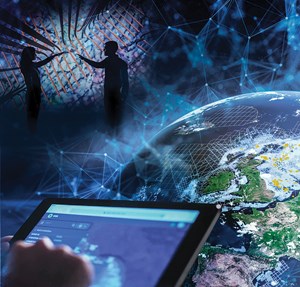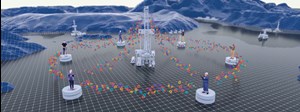Opening our minds will deliver lasting change
The radio broadcaster on the station that I was listening to the other morning announced, “I’m speaking to you live from our broadcasting center.” Then, after a pause, he humbly added, “Actually I’m not, I’m speaking to you live from my spare room.” While this is paraphrased a little, it was a highly effective way for him to summarize, in just a few words, the reality of what so many are calling, “the new normal.” To me, it was more significant. He personified people’s willingness to change, when change offers what they need.
Empowered by digital technology, and compelled by the Covid-19 lockdown, billions of us around the world are working from our kitchen tables, home offices…spare rooms. We’ve adopted these remote spaces as our “broadcasting centers,” and, by and large, it’s working. But will it last beyond the current pandemic? Is this really the new normal, or just the normal for now?”
In the oil and gas industry, we’ve typically been considered laggards when it comes to embracing digital technologies and solutions. While other sectors are a long way down the digital road, some would say the oil and gas industry has just opened the front door and is about to set off.
Yet, at the start of this year, who would have thought that within a few months, the majority of oil and gas workers would be working remotely? We have customer teams working on large volume, complex data entities, and producing high-resolution seismic models from their homes. It is possible, and it is happening.
THE REAL NEW NORMAL IN OIL AND GAS
In tackling the unforeseen challenges to normal business operations faced by our industry in 2020, we’ve seen a profound willingness and ability to adapt and change quickly. However, I’m not one who considers the digitally enabled response to the pandemic as the new normal. To me, its value is in achieving something close to normal; maintaining business continuity while our teams stay home. This is just the tip of the iceberg. The broad swath of improvements digital will unleash is the beginning of the real new normal in oil and gas: continuous progress; continuous efficiency increases; continuous growth in productivity; and continuous performance improvement.
There’s a vast panorama of possibilities that digital technology is making a reality. They manifest themselves in three ways within our organizations:
- Directly, through line item solutions that customers “buy” and where they remain accountable for the business outcomes;
- Embedded, through packaged solutions, where services and expertise add value to technology, and responsibility for outcomes is shared between customer and supplier;
- Internal, through enterprise optimization, intrinsic capabilities that bring about efficiencies in the supplier’s own operations that enable savings to pass to customers.
These possibilities will be achieved more efficiently, and with more lasting impact, if our industry adopts openness.

COMMITTING TO OPENNESS
Only organizations that collaborate openly can develop the huge quantity of technologies required to drive our industry into the digital future at the accelerated pace we need. At Schlumberger, we successfully used technology collaborations to accelerate technology innovation, and we facilitate openness further through our solutions.
We have placed the OSDU™ data platform (the open data platform for the industry) at the center of our digital strategy. The platform was built by a cross-industry collaboration, using open source code contributed by Schlumberger from its data ecosystem, which forms the foundation of the DELFI* cognitive E&P environment. It is an important development for our industry, because it enables operators of all sizes to custom-build software on common industry data foundations. The result is unlimited flexibility in the use of data between applications and domains—accelerating quality decision-making, empowering innovation and enhancing business strategies.
With the GAIA* data discovery & marketplace platform, we have made data available to all users from anywhere in the world, Fig. 1. With open access to structured data—seismic, wells and production—and unstructured content, such as news and market reports, users can discover, visualize, screen and interact with all available data in a region or basin without compromising resolution and scale. This means they can quickly evaluate data to ensure it meets near- and long-term business objectives.
The advantages of this technology can be seen in a recent project in Egypt, known as the Egypt Upstream Gateway (EUG). In a unique collaboration with the Egyptian Ministry of Petroleum, we used the GAIA platform to integrate all relevant data and workflows into a personalized data discovery experience. All relevant cross-domain data are quickly accessible by oil and gas companies through a subscription model, with multiple third-party vendors collaborating to provide content. The EUG ensures Egypt’s subsurface data are kept evergreen, and it promotes Egypt’s E&P potential worldwide, attracting new investment from around the world.
OPENNESS AT THE EDGE

Breaking down silos between domain teams has been one of the lead mantras of our call for more openness, Fig. 2. So, when we saw a situation where silos were beginning to exist between our industry’s large, and growing, array of intelligent field equipment, we developed a new digital solution that connects them with each other and augments their individual capabilities. Agora* edge AI and IoT solutions, a Schlumberger startup venture, provides an open-edge interface that enables the use of any hardware from any manufacturer. It is designed specifically for oil and gas, and can be used with multiple cloud providers. The Agora solution empowers innovation through a partnership ecosystem that enables anyone to develop the specific solutions that they need.
The Agora solution utilizes edge applications that are integrated with artificial intelligence (AI), which helps increase operational performance and reliability by making use of every piece of data. Insights from the edge make a difference to working lives. Today, sending people to the field to check equipment is unnecessary. This dangerous and time-consuming task has been replaced by data streaming directly from the equipment to alert the operator of issues and potential failures. Even corrective actions are performed remotely or via automation. As well as increasing safety, this reduction in unnecessary trips to the field is lowering the environmental impact.
You can see the huge impact of edge computing in a project recently delivered by Agora, Sensia and other Schlumberger technologies, in which edge computing was applied to remote production wells in the jungles of Ecuador. We used machine learning at the edge, powered by Agora, to prevent damage to ESPs from unwanted gas production. The AI solutions gave us greater control, scope and accuracy in surface measurements, and we were able to significantly reduce gas ingress by automating the control of the flowrate at the pump, using Sensia technology. The project achieved a return on investment in just seven days. What was really interesting were the incremental effects—visits to site were reduced from 60 per month to just two, with all the associated risk and fuel reductions, and we also realized an extra 50 bpd of oil production.
OPENNESS MEANS DIGITAL TRANSFORMATION FOR ALL
To be truly open, we must be truly inclusive. Our aim has always been to bring digital opportunities to all our customers; to everyone, no matter what size, or country they are operating in—digital transformation should not be reserved only for those who have access to global clouds. Up until now, this has been a challenge in countries with limited technology access, local regulations or data residency requirements. However, a recent agreement between Schlumberger, IBM and Red Hat will leverage the OpenShift container platform to provide an industry-first solution to these issues.
OpenShift—the leading enterprise Kubernetes application platform—enables the DELFI cognitive E&P environment to be deployed across any infrastructure, from traditional data centers to hybrid and multi-clouds, including private and public, and scaled to meet business constraints and regulations. Many more oil and gas operators, suppliers and partners—from all regions of the world—will be enabled to deploy digital solutions.
Additionally, this collaboration will deliver the first hybrid cloud implementation of the OSDU data platform, Fig. 3. These initiatives represent a major step on the industry’s digital transformation journey; we are establishing the open and flexible digital infrastructure that operators need.

MINDSET SHIFT
Having all parties involved in a project such as this, willing to work together, is a mindset change for us all, yet it is essential. Changing the way that we think and act will make us more effective as an industry. New, collaborative approaches to problem-solving enable the development of digital technology that can deliver business outcomes that have never been possible before. This is the model we are using, with our partners, to create fit-for-purpose solutions for our customers.
We see the change in mindset demanded by digital transformation as a shift in three principle areas: internally, externally and environmentally.
Internally, there are new ways to optimize our entire operation. Our teams no longer need to spend as much time at the wellsite or in the field. Cloud-hosted E&P software and infrastructure mean many operations can be performed successfully, remotely. This has been demonstrated across the world during the pandemic; but it was digitally enabled and strategically implemented long before.
Digitally transformed remote operations stream real-time data from all domains, to enable real-time decisions to be made with input from all required experts, such as drilling and reservoir engineers. Previously, we had an operator monitoring multiple screens and feeding back instructions to the field. Today, the customer is at the center of their operation and can work more collaboratively with the service company than has ever been possible before, with access to experts from all domains. We have found that they can support five times as many operations without physically traveling to each location.
Through increased capability and capacity in remote operations, and working together with our customers, we have reduced the wellsite footprint and HSE exposure. Our remote drilling operations have expanded by over 25%, quarter on quarter (first quarter to second quarter), during the first half of 2020. This accounts for two-thirds of our total drilling activity, and by the second quarter, we had drilled 1,250 wells remotely. Remote drilling minimizes trips to the field, which ultimately reduces HSE exposure and greenhouse gas emissions (GHGs). These advantages come with reductions in operational costs and have set new benchmarks for operational efficiency while slashing non-productive time.
It is proven that collaborative teams achieve more. Connecting teams across the E&P life cycle, from planning to production, enables performance improvements on an unprecedented scale, with time to first oil slashed and output maximized.
Externally, a considerable change in approach is possible. Through cloud-based E&P environments, experts from all domains have access to data derived from intelligent hardware and smart instrumentation. Domain teams can stop thinking (and working) in silos, and instead, work as one efficient unit across the entire E&P life cycle. It’s a true step change in how our industry has traditionally operated. No one should consider a single domain in isolation anymore. They are all connected.
Schlumberger, along with our customers, has already shared some of the successes achieved using digital solutions. Woodside, our first enterprise-wide DELFI deployment, is one such customer. The Woodside and Schlumberger team, collaborating closely via the DELFI environment, was able to reduce a subsurface modeling workflow from 18 months to just eight days, using the FDPlan* agile field development planning solution.
Environmentally, all this is of benefit, too. Monitoring, and therefore reducing, GHG emissions associated with operations is now much simpler, and there is a positive knock-on effect of more efficiency and better information—decreasing the environmental impact associated with oil and gas activity. The willingness to share what was previously unthinkable to share—even the reasons for successes and failures—saves time and resources, and sets us on a path toward a safer, cleaner oil and gas industry. This is a path toward solving the Dual Challenge—meeting rising demand for affordable energy to raise living standards globally, while directly addressing the issue of sustainability.
Only through digital transformation can we fulfill our responsibility of helping the world meet its demand for affordable, reliable and sustainable energy, now and in the future.
PEOPLE ARE THE ULTIMATE DRIVER
Digital transformation requires profound change. And change happens when people make it happen. The new way of working that we’ve all adapted to in response to Covid-19 is enabled by digital technology and solutions. Can we make it stick for the long-term?
The pressures and challenges we are facing as an industry must be addressed fully; they go far deeper than the pandemic and beyond it. We need fundamental change at all levels, if we are to meet world energy needs affordably and sustainably, while remaining viable and profitable for the future of our businesses.
By embracing openness, by recognizing the value of partnerships and collaboration, and by sharing information and data, we will develop better solutions quickly, and our industry will become more sustainable, and more responsible, faster. It is a common misconception that people object to change; indeed, it is well-known, and proven once again by Covid-19, that people adapt willingly to new situations, when there is a better alternative. Digital transformation offers the improvement that our industry is seeking, and this is why digital transformation is the change that our people will embrace. Forever.
*Mark of Schlumberger or Schlumberger companies.
- Digital transformation/Late-life optimization: Harnessing data-driven strategies for late-life optimization (March 2024)
- The reserves replacement dilemma: Can intelligent digital technologies fill the supply gap? (March 2024)
- Digital tool kit enhances real-time decision-making to improve drilling efficiency and performance (February 2024)
- Digital transformation: Digital twins help to make the invisible, visible in Indonesia’s energy industry (January 2024)
- Digital transformation: A breakthrough year for digitalization in the offshore sector (January 2024)
- Quantum computing and subsurface prediction (January 2024)
- Applying ultra-deep LWD resistivity technology successfully in a SAGD operation (May 2019)
- Adoption of wireless intelligent completions advances (May 2019)
- Majors double down as takeaway crunch eases (April 2019)
- What’s new in well logging and formation evaluation (April 2019)
- Qualification of a 20,000-psi subsea BOP: A collaborative approach (February 2019)
- ConocoPhillips’ Greg Leveille sees rapid trajectory of technical advancement continuing (February 2019)


